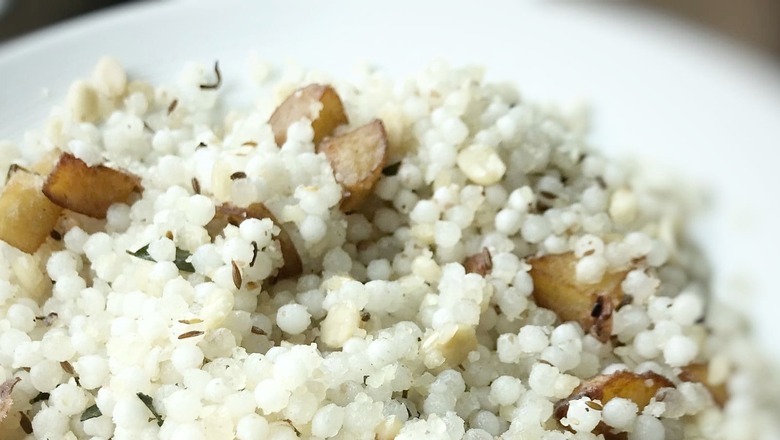
views
I’ve written about Shraavan Food several times before, yet I cannot cease or desist to write about it once again. There are a couple of reasons for that, first and foremost, I just love the ‘sattvic’ food that is cooked and eaten during this holy month. This coming from an unquestioned and verified carnivore like me, may sound a bit feigned and phony and even fraudulent. But trust me, I scrupulously mean it. I really like the simplicity, the modesty, the minimal use of spices, the sanctity of the food and the deep-rooted philosophy of the choices, which are completely in synch with time and nature.
‘Shraavan’ is the month of the rains, and with the rains come digestive issues. How often have you been told, “Don’t eat out in the monsoon?”. It’s not just your mother nagging you, there is a thousand years of truth behind this siren.
For instance, while old time-tested practices and traditions dictate that the month of ‘Shraavan’ calls for a fully vegetarian meal; leafy, green vegetables are a complete no-no and are shunned. Is it just blind superstition or is there a scientific reason why non-vegetarian food as well as leafy vegetables should be avoided during this month?
Let’s address non-vegetarian food to start off with. Our scriptures and traditions explain that during the rainy season, the lack of sunlight makes our body weak and our body’s digestive system turns sluggish and it is at its worst during ‘Shraavan’.
‘Shraavan’ is also breeding season for fish. So, if we fish in this season, it interrupts their breeding cycle causing the species irredeemable harm. So, the wisdom of our forefathers advises us to stay in harmony with our environment by avoid fishing and hence consuming fish during this season. Avoiding slaughtering animals, I suppose is also part of the same philosophy.
As far vegetables are concerned, however nutritious and healthy you may think leafy vegetables are, they are great for you throughout the year, except during the month of ‘Shraavan’. Why? There is an explanation. Monsoon is the breeding time for water-borne diseases. Leafy vegetables in the rains are thriving with germs and insects turn into a hatchery for a variety of microbes and bacteria. Especially, vegetables like brinjal and cauliflower. Brinjal itself is not considered a pure and auspicious food according to the Hindu scriptures. It’s just not myth and fable. There is a scientific reason for that. The bulbous eggplant produces alkaloids in the monsoon season to protect itself from insects. These same alkaloids while saving the brinjal could give us digestive problems, infections and allergies like hives, itchy skin, nausea, and skin rashes. And as far as the cauliflower goes, it contains compounds called glucosinolates, which are really not friendly to our digestive systems. That’s why tradition insists we don’t eat them during ‘Shraavan’.
What we do eat are tubers and root vegetables like potato, elephant yam (suran), ‘shakharkand’ (sweet potato), ‘ratalu’ (purple yam). Vegetables that are water-based and easy on the stomach such as bottle gourd (dudhi), pointed gourd (parval), ridge gourd (toori), Colocasia leaves. Also sabudana, (tapioca pearls), rajgira (amaranth), singhada (water chestnut) buckwheat and millet. And, of course, milk, yogurt, butter milk, butter and ghee.
In Mumbai, a few restaurants rejig their menus to serve ‘saatvik shraavan’ food or what is called “farali” or fasting food.
‘Soam’ serves innovative ‘farali’ food. Khatta Meetha Kaddu, (bottle gourd flatbreads and Buckwheat flour) served with sweet and sour pumpkin curry. On the menu is also ‘farali undhiyo’ served with puris, ‘farali kofta’ curry with parathas, ‘farali sev puri’, ‘shakharkand ki chaat’, pineapple ‘sheera’ and ‘kopra pak’.
‘Diva Maharashtracha’ for several years have been exploring ‘Shraavan’ food, and this year’s menu includes Farali Kachori, Four Flour Thaalieeth, Banana Thalipeeth, Sabudana Khichdi, Shingada Moong Cashew Puris, Batata Watana Suki Bhaaji, Pineapple Amti, Moong and fresh Cashew Usal.
The only problem with fasting food is that while the intention is to detox and give the stomach a rest, the food itself is so tasty that I invariably land up overeating all this lovely food, so generously laden with ghee and starch. Seems to me, whether it is ‘Shraavan’ or not, for me, there is just no season of rest.
Kunal Vijayakar is a food writer based in Mumbai. He tweets @kunalvijayakar and can be followed on Instagram @kunalvijayakar. His YouTube channel is called Khaane Mein Kya Hai. The views expressed in this article are those of the author and do not represent the stand of this publication.
Read all the Latest News and Breaking News here




















Comments
0 comment